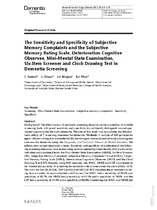| dc.contributor.author | Ramlall, Suvira | |
| dc.contributor.author | Chipps, Jennifer | |
| dc.contributor.author | Bhigjee, Ahmed | |
| dc.contributor.author | Pillay, Basil | |
| dc.date.accessioned | 2014-11-10T08:01:59Z | |
| dc.date.available | 2014-11-10T08:01:59Z | |
| dc.date.issued | 2013 | |
| dc.identifier.citation | Ramlall, S., Chipps, J. Pillay, B. J., Bhigjee, A E. (2013). The sensitivity and specificity of subjective memory complaints and the subjective memory rating scale, deterioration cognitive observee, mini-mental state examination, six-item screener and clock drawing test in Dementia Screening. Dementia and Geriatric Cognitive Disorders, 36: 119-135 | en_US |
| dc.identifier.issn | 1420-8008 | |
| dc.identifier.uri | http://hdl.handle.net/10566/1300 | |
| dc.description.abstract | Background: The effectiveness of dementia screening depends on the availability of suitable screening tools with good sensitivity and specificity to confidently distinguish normal age-related cognitive decline from dementia. The aim of this study was to evaluate the discriminant validity of 7 screening measures for dementia. Methods: A sample of 140 participants aged ≥60 years living in a residential facility for the aged were assessed clinically and assigned caseness for dementia using the Diagnostic and Statistical Manual of Mental Disorders, 4th edition, text revised diagnostic criteria. Sensitivity and specificity of a selection of the following screening measures were tested using receiver operating characteristic (ROC) analysis for individual and combined tests: the Mini-Mental State Examination (MMSE), Six-Item Screener (SIS), Subjective Memory Complaint, Subjective Memory Complaint Clinical (SMCC), Subjective Memory Rating Scale (SMRS), Deterioration Cognitive Observee (DECO) and the Clock Drawing Test (CDT). Results: Using ROC analyses, the SMCC, MMSE and CDT were found to be ‘moderately accurate' in screening for dementia with an area under the curve (AUC) >0.70. The AUCs for the SIS (0.526), SMRS (0.661) and DECO (0.687) classified these measures as being ‘less accurate'. At recommended cutoff scores, the SMCC had a sensitivity of 90.9% and specificity of 45.7%; the MMSE had a sensitivity of 63.6% and a specificity of 76.0%, and the CDT had a sensitivity of 44.4% and a specificity of 88.9%. Combining the SMCC and MMSE did not improve their predictive power except for a modest increase when using the sequential rule. Conclusion: The SMCC is composed of valid screening questions that have high sensitivity, are simple to administer and ideal for administration at the community or primary health care level as a first level of ‘rule-out' screening. The MMSE can be included at a second stage of screening at the general hospital level and the CDT in specialist clinical settings. Sequential use of the SMCC and MMSE will improve the specificity of the former and the sensitivity of the latter. | en_US |
| dc.language.iso | en | en_US |
| dc.publisher | Karger | en_US |
| dc.rights | This file is the author post-print version of an article published by Karger. | |
| dc.source.uri | http://dx.doi.org/10.1159/000350768 | |
| dc.subject | Screening | en_US |
| dc.subject | Mini-mental state examination | en_US |
| dc.subject | Subject memory complaints | en_US |
| dc.subject | Sensitivity | en_US |
| dc.subject | Specificity | en_US |
| dc.title | The sensitivity and specificity of subjective memory complaints and the subjective memory rating scale, deterioration cognitive observee, mini-mental state examination, six-item screener and clock drawing test in Dementia Screening. | en_US |
| dc.type | Article | en_US |
| dc.privacy.showsubmitter | false | |
| dc.status.ispeerreviewed | true | |
| dc.description.accreditation | Department of HE and Training approved list | en_US |

